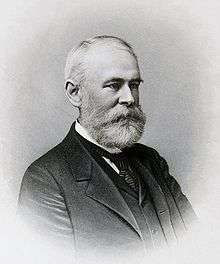George Lansing Raymond
George Lansing Raymond, (1839–1929)[1] was a prominent professor of Aesthetic Criticism at Princeton University (1881–1905)[2] and author of a new system of esthetics. He was nominated for the Nobel Prize in Literature seven times.[3]
George Lansing Raymond | |
|---|---|
 | |
| Occupation | professor and author |
He also served as a professor at George Washington University (D.C.) and Williams College (his alma mater).
Career
Author of a systematic theory of art published by G.P. Putnam, published in seven volumes during the period 1886 to 1900, and republished as a set of uniform volumes in 1909. Additionally an eighth volume was published, as a summary of the seven volumes, titled, Essentials of Esthetics. A volume of excerpts of his seven books, edited by the classical scholar Marion Mills Miller, was also published by Putnam in 1920. (see publication list below)
Raymond was an art theorist who created the first comprehensive and systematic theory of the arts.[4] The New York Times said "In a spirit at once scientific and that of the true artist, he pierces through the manifestations of art to their sources, and shows the relations, intimate and essential, between painting, sculpture, poetry, music, and architecture." [5]
He was rare among art theorists of the time (and since), to use psychology and physiology and biological factors to ground his art theory, and to use detailed discussions of specific art works to validate his views.[6]
His work is neglected, although some scholars say his system deserves resurrection.[7][8]
His basic approach is as stated in his summary one-volume book Essentials of Esthetics: "The phenomena of the arts of the highest class have been traced [in this book] to their sources in material nature and in the human mind; the different arts have been shown to be developed by exactly similar methods; and these methods have been shown to characterize the entire work of artistic imagination, from the formulation of psychical concepts to that of their most physical expressions in rhythm, proportion and harmony."
He was also a vocal advocate of a scientific and rational Christianity. He seemed to be following in Aquinas’ footsteps in believing he could rationalize religious belief with science.
He was also a widely published poet during the latter part of the 19th century, though with no lasting celebrity.
He wrote works on oratory (i.e., rhetoric), early in life, since he a professor of oratory; and later in life after retiring from his professorships, he wrote a book on ethics and natural law.
Three of his books (the last two in the esthetic book list above, and one on ethics) are available in full digital text form at subscriber website www.questia.com. In 2008 and 2009, all of these books were re-published by Kessinger Publishing and Bibliolife Publishing in hardcover and paperback. The title "Genesis of Art-Form" is also accessible for free at www.esthetics.cc (along with an archival copy of the New York Times 1893 book review of that book). Most of his series of seven volumes comprising his seven volumes on aesthetics is available in digital form at books.google.com.
Personal life
Raymond was the son of Benjamin Wright Raymond, twice Mayor of Chicago. He was educated at Phillips Academy, Andover, graduating in 1858, and Williams College where he was a member of the Kappa Alpha Society. He married Mary Elizabeth Blake in 1872.
To see his New York Times Obituary: http://www.esthetics.cc/articles/Raymond%20-%20Obituary%20in%20NYT%201929.pdf
Bibliography
All works are published by G.P. Putnam's Sons, New York. This is only a list of Raymond's works on aesthetics.
- 1886 - Poetry as a Representative Art (reissued 1909)
- 1893 - Genesis of Art Form (reissued 1909) (See review from 1893):http://www.esthetics.cc/articles/nytimes_review_genesis.html
- 1894 - Art in Theory (reissued 1909)
- 1894 - Rhythm and Harmony in Poetry and Music; Music as a Representative Art (reissued 1909)
- 1895 - Painting, Sculpture and Architecture as Representative Arts (reissued 1909)
- 1899 - Proportion and Harmony of Line and Color in Painting, Sculpture and Architecture (reissued 1909)
- 1900 - Representative Significance of Form (reissued 1909)
- 1906 - Essentials of Esthetics (reissued 1909? and 1921) Summary textbook of first seven volumes
- 1920 - An Art Philosopher's Cabinet (reissued 1926?) edited by Marion Mills Miller
References
- Internet Archive Search: george lansing raymond
- General Catalogue of Princeton University 1746-1906, p.35 and 36, available via books.google.com
- "Nomination Database". www.nobelprize.org. Retrieved 2017-04-19.
- An Art-Philosopher’s Cabinet, Marion Mills Miller, G.P. Putnam’s Sons, 1915, page ix of introduction
- quoted in, An Art-Philosopher’s Cabinet, Marion Mills Miller, G.P. Putnam’s Sons, 1915, page x of introduction
- Journal of Aesthetics and Art Criticism, [JAAC articles available to JSTOR subscribers] Thomas Munro, v.13 p.533-537
- Journal of Aesthetics and Art Criticism , Vol. 19 no.3 p.327-337
- Journal of Aesthetics and Art Criticism, “The Strange Neglect of G. L. Raymond.”, Thomas Munro, v.13 p.533-537
External links
- Men of Mark in America Biography
- George Lansing Raymond at Find a Grave